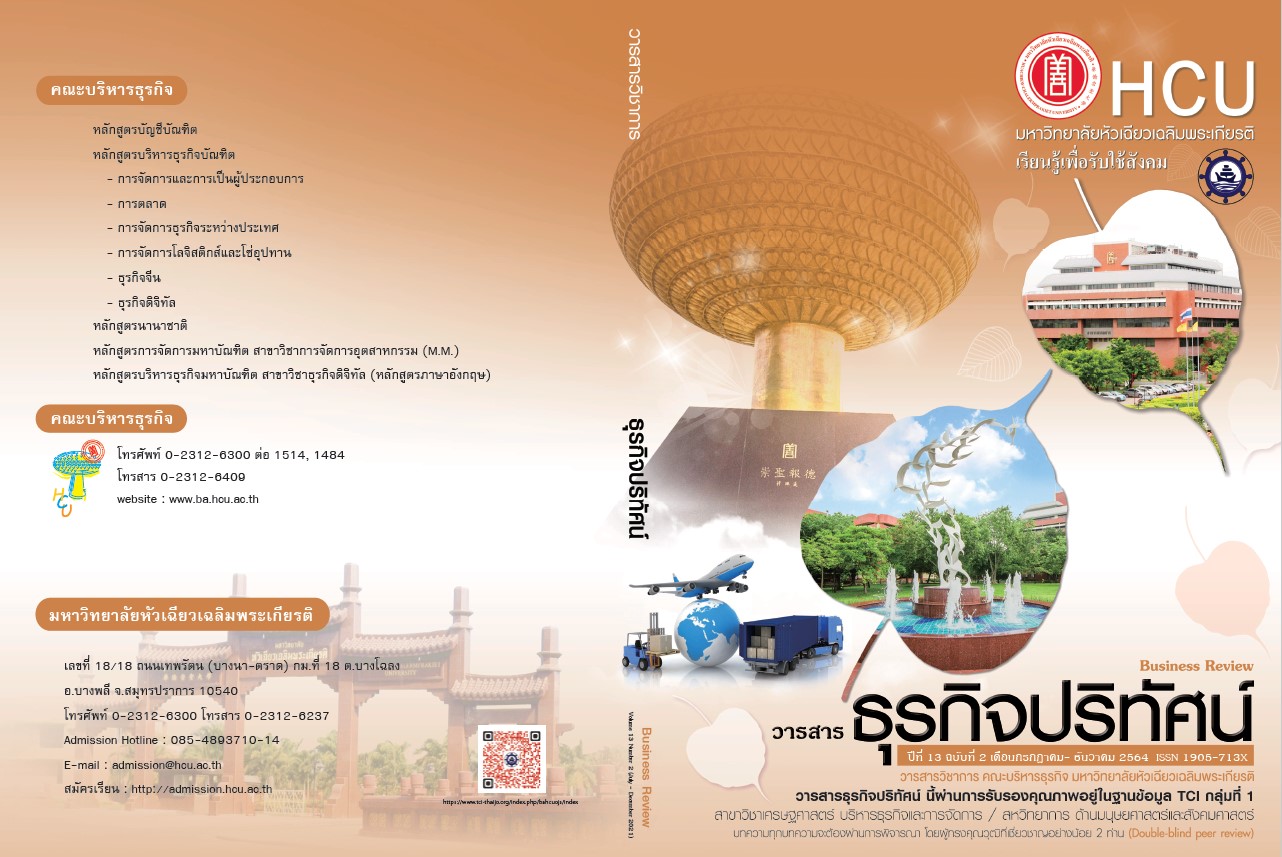A Study of the Relationship of Physical Environment to Third Place in Central Festival Hat Yai Shopping Center, Songkhla Province
Keywords:
Physical Environment, Third Place, Shopping CenterAbstract
In the current market situation, shopping centers have enhanced their experience of providing services to consumers as a third-place. Which is the place that serve as an alternative to home and work. Because the shopping center has an environment and service, both shops and facilities that meet the needs of consumers fully. This research was aims to (1) study the physical environment affecting the third-place concept and (2) to confirm that the third-place affecting the intention to visit the Central Festival Hadyai shopping center. The sample group is 400 consumers who visit the Central Festival Hat Yai shopping center. Which this research is quantitative research. The method of data collection is questionnaires by using convenient sampling methods from 400 sets of samples. The statistics data analyses were the percentage, mean, and multiple regression analysis. The results showed that the physical environment in its location ( =0.338) and the tenant shop ( =0.456) affect towards on the third-place with statistical significance at 0.05. While the third-place also affecting the intention to visit the shopping center with statistical significance at 0.05.
References
กาญจนา วุฒิพงศ์ปรีชา. (2011). แนวทางการจัดสภาพแวดล้อมทางกายภาพพื้นที่ที่สามเพื่อการพบปะทางธุรกิจ. วิทยานิพนธ์ปริญญามหาบัณฑิต, สถาบันเทคโนโลยีพระจอมเกล้าเจ้าคุณทหารลาดกระบัง.
คณะกรรมการนโยบายเขตพัฒนาเศรษฐกิจพิเศษ. (2018). รายงานความก้าวหน้าการพัฒนาเขตพัฒนาเศรษฐกิจพิเศษเมษายน 2561. สืบค้นเมื่อ 10 มีนาคม 2562, เว็บไซต์ http://www.nesdb.go.th/ ewt_ dl_link.php?nid=7551.
ปรียา เทศนอก. (2019). พื้นที่ค้าปลีกเปิดใหม่ปี’61เติบโตจากปีก่อนกว่า 96%. สืบค้นเมื่อ 7 เมษายน 2562, เว็บไซต์ https://www.prop2morrow.com.
ปพนธ์ มังคละธนะกุล. (2016). Starbucks:the third place. สืบค้นเมื่อ 2 สิงหาคม 2561, เว็บไซต์ https://thaipublica.org/2016/10/yangsamkum4/.
ผู้จัดการออนไลน์. (2018). อบจ.สงขลา เปิดเวทีรับฟังความคิดเห็นประชาชน โครงการระบบขนส่งมวลชนโดยระบบราง. สืบค้นเมื่อ 3 พฤษภาคม 2561, เว็บไซต์ https://mgronline.com/south.
ภรัณย์พงศ์ เอกบุศย์. (2010). คุณลักษณะพื้นที่ที่สามของชุมชนมหาวิทยาลัยธรรมศาสตร์(ศูนย์ รังสิต). วิทยานิพนธ์ปริญญามหาบัณฑิต, มหาวิทยาลัยธรรมศาสตร์.
มนตรี อัสนีกร. (2016). วิธีการเลือกทำเลที่ตั้ง-ร้านค้าปลีก-ให้โดน. สืบค้นเมื่อ 10 ตุลาคม 2562, เว็บไซต์ http://www.thaismescenter.com/
วรรณศิริ สิทธินิสัยสุข. (2016). ปัจจัยที่ส่งผลต่อความตั้งใจการเลือกซื้อผลิตภัณฑ์เสริมอาหารของนิสิตระดับปริญญาตรี. งานนิพนธ์บริหารธุรกิจมหาบัณฑิต, วิทยาลัยพาณิชยศาสตร์, มหาวิทยาลัยบูรพา.
ศูนย์วิจัยกสิกรไทย (2019). ค้าปลีกปี 2563: คาดโต 2.8% ..กำลังซื้อผู้บริโภคยังคงกดดันการเติบโตของธุรกิจอย่างต่อเนื่อง. สืบค้นเมื่อ 2 มกราคม 2563, เว็บไซต์https://kasikornresearch.com/th/analysis/k-econ/business/Pages/z3052.aspx.
Band Buffet. (2018). 3 กลยุทธ์ CPN รับมือผู้บริโภคเปลี่ยน สู่ “Center of Life” เมื่อศูนย์การค้าต้องเป็นมากกว่าแค่ที่ช้อปปิ้ง. สืบค้นเมื่อ 1 กุมภาพันธ์ 2562, เว็บไซต์ https://www.brandbuffet.in.th/2018/06/cpn-co-create-to-center-of-life/
Ajzen, I. (1991). The theory of planned behavior. Organizational behavior and human decision processes, 50, 179–211.
Anne, P.C. (2011). Rethinking Oldenburg :Third places and Generation Y in a developing country context. International CHRIE Conference-Refereed, 7, 1-22.
Blower, G. (2013). A critical analysis of the third place concept for acquiring and retaining millennial custom whilst developing brand loyalty in a successful coffee house chain. Undergraduate Dissertation, Winchester Business School.
Camp, H. B. (2015). A study of third place: Benefits of shared leisure practices in Public gathering places. Ph. D. Thesis, Middle Tennessee State University, USA.
Chatzopoulou, E.,and Tsimonis, G. (2010). Shopping Malls: Just Another Shopping Place? The Case of Physical Environment Quality. Academy of Marketing Conference, 1-12.
Chatzopoulou, E., Tsiotsou, R.,and Sirakoulis, K. (2011). Examining the effect of gender on motivational factors for visiting shopping malls. The International Conference on Corporate and Marketing Communications, 16, 362-363.
Gaurav, B., and Achyut, T. (2017). Factors Influencing Customer Satisfaction in Retail Malls in Hyderabad: A Study. Marketing and Consumer Research, 36, 50-57.
Howard, E. (2007). New shopping centres: is leisure the answer?. International Journal of Retail & Distribution Management, 35(8), 661-672.
Leonardo, O.C.,and Marcelo, R.V. (2017). Attraction factors of shopping centers: Effects of design and eco-natural environment on intention to visit. European Journal of Management and Business Economics, 26(2), 199-219.
Levy, M.,and Barton, A. W. (1998). Retailing Management (3rd ed.). Chicago: Irwin McGrawHill.
Odeh, M. R., As’ad.,and H. Abu-Rumman. (2014). The impact of Jordanian shopping malls’ physical surrounding on consumer buying behavior: Field study. International Journal of marketing studies, 6(3), 135-141.
Oldenburg, R. (1989). The great good place. New York: Marlowe.
Oldenburg, R.,& Brissett, D. (1982). The third place. Qualitative Sociology, 5(4), 265-284.
Purnell, D. (2015). Expanding Oldenburg: home as third place. .Journal of Place Management and Development, 8(1), 51-62.
Putnam, R. D. (2000). Bowling alone: The collapse and revival of American community.New York:Simon& Schuster.
Rosenbaum, S. M. (2003). The role of third places in older customers’lives. A Dissertation Degree Doctor of Philosophy, Arizona State University.
Sadachar, A. (2014). Indian consumers' patronage intention toward shopping malls: Application of an experience economy perspective, Graduate Theses and Dissertations, Iowa State University.
Shaare, A., and Nur, S. M. (2018). Young adults’ satifaction towards Hipster Cafes: The Brewing factors. Advances in Business Research International Journal, 41-52.
Tumanan, R.,Mary, A.,& Joseph, R. G. L. (2012). More than just a cuppa coffee: A multi-dimensional approach towards analyzing the factors that define place attachment.
International Journal of Hospitality Management, 31, 529– 534.
Ute, W.,& Bo, E. (2012). The physical environment as a driver of customers' service experiences at restaurants. International Journal of Quality and Service Sciences. 4(2), 104-119.
Vashisht, A., Wadhwa, B.,and Shauppal, A. (2014). Study of attitude of Delhi shoppers towards mall shopping experience. Journal of Research in Commerce & Management, 3(10), 42-50.
Yeh, S.,& Huan, T. (2017). Assessing the impact of work environment factors on employee creative performance of fine-dining restaurants. Journal of Tourism Management, 58, 119-131.
Downloads
Published
How to Cite
Issue
Section
License
All articles published in the Business Administration and Management Journal Review are copyrighted by the journal.
The views and opinions expressed in each article are solely those of the individual authors and do not represent those of Huachiew Chalermprakiet University or any other faculty members. Each author is fully responsible for the content of their own article. Any errors or issues found are the sole responsibility of the respective author.




